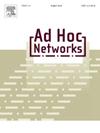QRAVDR: A deep Q-learning-based RSU-Assisted Video Data Routing algorithm for VANETs
IF 4.4
3区 计算机科学
Q1 COMPUTER SCIENCE, INFORMATION SYSTEMS
引用次数: 0
Abstract
With the rapid development of Internet of Vehicles (IoV) and the increasing demand for video services, video data routing in Vehicular Ad-hoc Networks (VANETs) has become a popular research topic. Challenges such as real-time transmission demands, instability of wireless channels, and high network topology dynamics significantly affect video transmission quality. Although some related studies have used multipath transmission and priority scheduling to improve performance, they usually require accurate models or use a static approach to make decisions, which lack the learning mechanism and the ability to adapt to the dynamic network, resulting in poor video reconstruction quality. To address the above problems, A Deep Q-Learning (DQL)-based RoadSide Unit (RSU)-Assisted Video Data Routing algorithm, named QRAVDR, is proposed for urban VANET environments. The algorithm coordinates the forwarding road segments of different layers of Scalable Video Coding (SVC) video data at the RSUs through DQL, maximizing the video quality at the receiver while minimizing the transmission delay. The Neutrosophic Set Analytic Hierarchy Process method is applied to select the best relay vehicle within the road segments, which guarantees the transmission of keyframes and improves the decoding possibility. Extensive simulation experiments on QRAVDR and other existing algorithms have been conducted using NS-2 employing simulated datasets. The results show that QRAVDR achieves a better overall performance in improving the average frame delivery ratio by about 8.02%, reducing the average end-to-end delay by approximately 9.61%, and improving the average peak signal-to-noise ratio by roughly 7.97%.
基于深度q学习的rsu辅助vanet视频数据路由算法
随着车联网(IoV)的快速发展和对视频业务需求的不断增长,车载自组网(VANETs)中的视频数据路由已成为一个热门的研究课题。实时传输需求、无线信道的不稳定性、网络拓扑的高动态性等问题严重影响视频传输质量。虽然一些相关研究采用多路径传输和优先级调度来提高性能,但通常需要精确的模型或采用静态的方法进行决策,缺乏学习机制和适应动态网络的能力,导致视频重构质量较差。为了解决上述问题,提出了一种基于深度q学习(DQL)的路边单元(RSU)辅助视频数据路由算法,称为QRAVDR,用于城市VANET环境。该算法通过DQL协调各层SVC (Scalable Video Coding)视频数据在rsu上的转发路段,最大限度地提高接收端的视频质量,同时使传输延迟最小化。采用中性集层次分析法在路段内选择最佳中继车辆,保证了关键帧的传输,提高了解码的可能性。利用NS-2利用模拟数据集对QRAVDR和其他现有算法进行了大量的模拟实验。结果表明,QRAVDR总体性能较好,平均帧发送比提高约8.02%,平均端到端延迟降低约9.61%,平均峰值信噪比提高约7.97%。
本文章由计算机程序翻译,如有差异,请以英文原文为准。
求助全文
约1分钟内获得全文
求助全文
来源期刊

Ad Hoc Networks
工程技术-电信学
CiteScore
10.20
自引率
4.20%
发文量
131
审稿时长
4.8 months
期刊介绍:
The Ad Hoc Networks is an international and archival journal providing a publication vehicle for complete coverage of all topics of interest to those involved in ad hoc and sensor networking areas. The Ad Hoc Networks considers original, high quality and unpublished contributions addressing all aspects of ad hoc and sensor networks. Specific areas of interest include, but are not limited to:
Mobile and Wireless Ad Hoc Networks
Sensor Networks
Wireless Local and Personal Area Networks
Home Networks
Ad Hoc Networks of Autonomous Intelligent Systems
Novel Architectures for Ad Hoc and Sensor Networks
Self-organizing Network Architectures and Protocols
Transport Layer Protocols
Routing protocols (unicast, multicast, geocast, etc.)
Media Access Control Techniques
Error Control Schemes
Power-Aware, Low-Power and Energy-Efficient Designs
Synchronization and Scheduling Issues
Mobility Management
Mobility-Tolerant Communication Protocols
Location Tracking and Location-based Services
Resource and Information Management
Security and Fault-Tolerance Issues
Hardware and Software Platforms, Systems, and Testbeds
Experimental and Prototype Results
Quality-of-Service Issues
Cross-Layer Interactions
Scalability Issues
Performance Analysis and Simulation of Protocols.
 求助内容:
求助内容: 应助结果提醒方式:
应助结果提醒方式:


